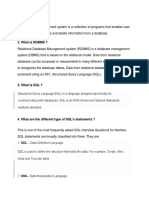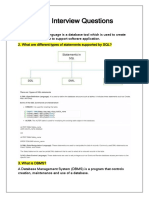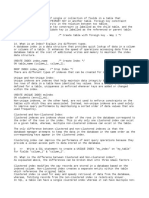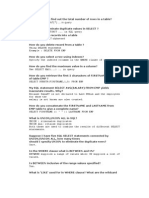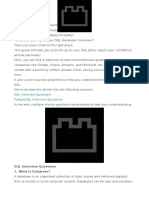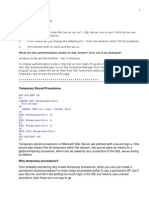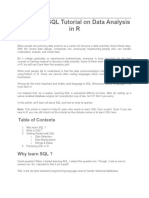Interview Questions: Placement Preparation
Interview Questions: Placement Preparation
Uploaded by
RITWIK MALCopyright:
Available Formats
Interview Questions: Placement Preparation
Interview Questions: Placement Preparation
Uploaded by
RITWIK MALOriginal Title
Copyright
Available Formats
Share this document
Did you find this document useful?
Is this content inappropriate?
Copyright:
Available Formats
Interview Questions: Placement Preparation
Interview Questions: Placement Preparation
Uploaded by
RITWIK MALCopyright:
Available Formats
SQL INTERVIEW QUESTIONS
PLACEMENT PREPARATION
[EXCLUSIVE NOTES]
[SAVE AND SHARE]
Curated By- HIMANSHU KUMAR(LINKEDIN)
HIMANSHU KUMAR(LINKEDIN)
https://www.linkedin.com/in/himanshukumarmahuri
𝑪𝑯𝑬𝑪𝑲𝑶𝑼𝑻 𝑨𝑵𝑫 𝑫𝑶𝑾𝑵𝑳𝑶𝑨𝑫 𝑴𝒀 𝑨𝑳𝑳 𝑵𝑶𝑻𝑬𝑺
𝑳𝑰𝑵𝑲- https://linktr.ee/exclusive_notes
1. What is SQL?
SQL stands for Structured Query Language. It is a language used to
interact with the database, i.e to create a database, to create a table in
the database, to retrieve data or update a table in the database, etc.
SQL is an ANSI(American National Standards Institute) standard. Using
SQL, we can do many things. For example - we can execute queries, we
can insert records into a table, we can update records, we can create a
database, we can create a table, we can delete a table, etc.
2. What is a database?
A Database is defined as a structured form of data storage in a
computer or collection of data in an organized manner and can be
pg. 1 | HIMANSHU KUMAR (LINKEDIN)
accessed in various ways. It is also the collection of schemas, tables,
queries, views, etc. Databases help us with easily storing, accessing,
and manipulating data held on a computer. The Database Management
System allows a user to interact with the database.
3. Does SQL support programming language features?
It is true that SQL is a language, but it does not support programming
as it is not a programming language, it is a command language. We do
not have conditional statements in SQL like for loops or if..else, we only
have commands which we can use to query, update, delete, etc. data in
the database. SQL allows us to manipulate data in a database.
4. What are the differences between SQL and PL/SQL?
Ans: Some common differences between SQL and PL/SQL are as
shown below:
SQL PL/SQL
SQL is a query execution or PL/SQL is a complete programming
commanding language language
SQL is a data-oriented language. PL/SQL is a procedural language
SQL is very declarative in nature. PL/SQL has a procedural nature.
It is used for manipulating data. It is used for creating applications.
We can execute one statement at a We can execute blocks of
time in SQL statements in PL/SQL
SQL tells databases, what to do? PL/SQL tells databases how to do.
pg. 2 | HIMANSHU KUMAR (LINKEDIN)
We can embed SQL in PL/SQL We can not embed PL/SQL in SQL
5. What is the difference between BETWEEN and IN
operators in SQL?
BETWEEN
The BETWEEN operator is used to fetch rows based on a range of
values.
For example,
SELECT * FROM Students
WHERE ROLL_NO BETWEEN 20 AND 30;
This query will select all those rows from the table. Students where the
value of the field ROLL_NO lies between 20 and 30.
IN
The IN operator is used to check for values contained in specific sets.
For example,
SELECT * FROM Students
WHERE ROLL_NO IN (20,21,23);
This query will select all those rows from the table Students where the
value of the field ROLL_NO is either 20 or 21 or 23.
6. Write an SQL query to find names of employees start
with 'A'?
The LIKE operator of SQL is used for this purpose. It is used to fetch
filtered data by searching for a particular pattern in the where clause.
The Syntax for using LIKE is,
SELECT column1,column2 FROM table_name WHERE column_name L
IKE pattern;
LIKE: operator name
pg. 3 | HIMANSHU KUMAR (LINKEDIN)
pattern: exact value extracted from the pattern to get rel
ated data in
result set.
The required query is:
SELECT * FROM Employees WHERE EmpName like 'A%' ;
You may refer to this article WHERE clause for more details on the LIKE
operator.
7. What is the difference between CHAR and VARCHAR2
datatype in SQL?
Both of these data types are used for characters, but varchar2 is used for
character strings of variable length, whereas char is used for character
strings of fixed length. For example, if we specify the type as char(5) then
we will not be allowed to store a string of any other length in this
variable, but if we specify the type of this variable as varchar2(5) then
we will be allowed to store strings of variable length. We can store a
string of length 3 or 4 or 2 in this variable.
8. Name different types of case manipulation functions
available in SQL.
There are three types of case manipulation functions available in SQL.
They are,
• LOWER: The purpose of this function is to return the string in
lowercase. It takes a string as an argument and returns the string
by converting it into lower case.
Syntax:
LOWER('string')
• UPPER: The purpose of this function is to return the string in
uppercase. It takes a string as an argument and returns the string
pg. 4 | HIMANSHU KUMAR (LINKEDIN)
by converting it into uppercase.
Syntax:
UPPER('string')
• INITCAP: The purpose of this function is to return the string with
the first letter in uppercase and the rest of the letters in
lowercase.
Syntax:
INITCAP('string')
9. What do you mean by data definition language?
Data definition language or DDL allows to execution of queries like
CREATE, DROP and ALTER. That is those queries that define the data.
10. What do you mean by data manipulation language?
Data manipulation Language or DML is used to access or manipulate
data in the database.
It allows us to perform the below-listed functions:
• Insert data or rows in a database
• Delete data from the database
• Retrieve or fetch data
• Update data in a database.
11. What is the difference between primary key and unique
constraints?
The primary key cannot have NULL values, the unique constraints can
have NULL values. There is only one primary key in a table, but there
can be multiple unique constraints. The primary key creates the
clustered index automatically but the unique key does not.
pg. 5 | HIMANSHU KUMAR (LINKEDIN)
12. What is the view in SQL?
Views in SQL are a kind of virtual table. A view also has rows and
columns as they are on a real table in the database. We can create a
view by selecting fields from one or more tables present in the
database. A View can either have all the rows of a table or specific
rows based on certain conditions.
The CREATE VIEW statement of SQL is used for creating views.
Basic Syntax:
CREATE VIEW view_name AS
SELECT column1, column2.....
FROM table_name
WHERE condition;
view_name: Name for the View
table_name: Name of the table
condition: Condition to select rows
13. What do you mean by foreign key?
A Foreign key is a field that can uniquely identify each row in another
table. And this constraint is used to specify a field as a Foreign key.
That is this field points to the primary key of another table. This usually
creates a kind of link between the two tables.
Consider the two tables as shown below:
Orders
O_ID ORDER_NO C_ID
pg. 6 | HIMANSHU KUMAR (LINKEDIN)
1 2253 3
2 3325 3
3 4521 2
4 8532 1
Customers
C_ID NAME ADDRESS
1 RAMESH DELHI
2 SURESH NOIDA
3 DHARMESH GURGAON
As we can see clearly, that the field C_ID in the Orders table is the
primary key in the Customers' table, i.e. it uniquely identifies each row
in the Customers table. Therefore, it is a Foreign Key in the Orders
table.
Syntax:
CREATE TABLE Orders
(
O_ID int NOT NULL,
ORDER_NO int NOT NULL,
C_ID int,
PRIMARY KEY (O_ID),
FOREIGN KEY (C_ID) REFERENCES Customers(C_ID)
)
pg. 7 | HIMANSHU KUMAR (LINKEDIN)
14. What is a join in SQL? What are the types of joins?
An SQL Join statement is used to combine data or rows from two or
more tables based on a common field between them. Different types of
Joins are:
• INNER JOIN: The INNER JOIN keyword selects all rows from both
the tables as long as the condition satisfies. This keyword will
create the result-set by combining all rows from both the tables
where the condition satisfies i.e the value of the common field will
be the same.
• LEFT JOIN: This join returns all the rows of the table on the left
side of the join and matching rows for the table on the right side of
the join. For the rows for which there is no matching row on the
right side, the result-set will be null. LEFT JOIN is also known as
LEFT OUTER JOIN
• RIGHT JOIN: RIGHT JOIN is similar to LEFT JOIN. This join returns
all the rows of the table on the right side of the join and matching
rows for the table on the left side of the join. For the rows for which
there is no matching row on the left side, the result-set will contain
null. RIGHT JOIN is also known as RIGHT OUTER JOIN.
• FULL JOIN: FULL JOIN creates the result-set by combining results
of both LEFT JOIN and RIGHT JOIN. The result-set will contain all
the rows from both tables. For the rows for which there is no
matching, the result-set will contain NULL values.
15. What is an index?
A database index is a data structure that improves the speed of data
retrieval operations on a database table at the cost of additional writes
and the use of more storage space to maintain the extra copy of data.
Data can be stored only in one order on a disk. To support faster access
according to different values, a faster search like binary search for
different values is desired. For this purpose, indexes are created on
pg. 8 | HIMANSHU KUMAR (LINKEDIN)
tables. These indexes need extra space on the disk, but they allow
faster search according to different frequently searched values.
16. What is table and Field?
Table: A table has a combination of rows and columns. Rows are called
records and columns are called fields. In MS SQL Server, the tables are
being designated within the database and schema names.
Field: In DBMS, a database field can be defined as - a single piece of
information from a record.
17. What is a primary key?
A Primary Key is one of the candidate keys. One of the candidate keys
is selected as most important and becomes the primary key. There
cannot be more than one primary key in a table.
18. What is a Default constraint?
The DEFAULT constraint is used to fill a column with default and fixed
values. The value will be added to all new records when no other value
is provided.
19. What is On Delete cascade constraint?
An 'ON DELETE CASCADE' constraint is used in MySQL to delete the
rows from the child table automatically when the rows from the parent
table are deleted. For more details, please read MySQL - On Delete
Cascade constraint article.
20. What is normalization?
pg. 9 | HIMANSHU KUMAR (LINKEDIN)
It is a process of analyzing the given relation schemas based on their
functional dependencies and primary keys to achieve the following
desirable properties:
1) Minimizing Redundancy
2) Minimizing the Insertion, Deletion, And Update Anomalies
Relation schemas that do not meet the properties are decomposed into
smaller relation schemas that could meet desirable properties.
21. What is Denormalization?
Denormalization is a database optimization technique in which we add
redundant data to one or more tables. This can help us avoid costly
joins in a relational database. Note that denormalization does not mean
not doing normalization. It is an optimization technique that is applied
after doing normalization.
In a traditional normalized database, we store data in separate logical
tables and attempt to minimize redundant data. We may strive to have
only one copy of each piece of data in the database.
22. Explain WITH clause in SQL?
The WITH clause provides a way relationship of defining a temporary
relationship whose definition is available only to the query in which the
with clause occurs. SQL applies predicates in the WITH clause after
groups have been formed, so aggregate functions may be used.
pg. 10 | HIMANSHU KUMAR (LINKEDIN)
23. What are all the different attributes of indexes?
The indexing has various attributes:
• Access Types: This refers to the type of access such as value-
based search, range access, etc.
• Access Time: It refers to the time needed to find a particular data
element or set of elements.
• Insertion Time: It refers to the time taken to find the appropriate
space and insert new data.
• Deletion Time: Time is taken to find an item and delete it as well
as update the index structure.
• Space Overhead: It refers to the additional space required by the
index.
24. What is a Cursor?
The cursor is a Temporary Memory or Temporary Work Station. It is
Allocated by Database Server at the Time of Performing DML
operations on Table by User. Cursors are used to store Database
Tables.
25. Write down various types of relationships in SQL?
There are various relationships, namely:
• One-to-One Relationship.
• One to Many Relationships.
• Many to One Relationship.
• Self-Referencing Relationship.
pg. 11 | HIMANSHU KUMAR (LINKEDIN)
26. What is a query?
An SQL query is used to retrieve the required data from the database.
However, there may be multiple SQL queries that yield the same
results but with different levels of efficiency. An inefficient query can
drain the database resources, reduce the database speed or result in a
loss of service for other users. So it is very important to optimize the
query to obtain the best database performance.
27. What is subquery?
In SQL a Subquery can be simply defined as a query within another
query. In other words, we can say that a Subquery is a query that is
embedded in the WHERE clause of another SQL query.
28. What are the different operators available in SQL?
There are three operators available in SQL namely:
1. Arithmetic Operators
2. Logical Operators
3. Comparison Operators
29. What is a trigger?
Trigger is a statement that a system executes automatically when there
is any modification to the database. In a trigger, we first specify when
the trigger is to be executed and then the action to be performed when
pg. 12 | HIMANSHU KUMAR (LINKEDIN)
the trigger executes. Triggers are used to specify certain integrity
constraints and referential constraints that cannot be specified using
the constraint mechanism of SQL.
30. What is the difference between DELETE and TRUNCATE
commands?
The DELETE statement removes TRUNCATE TABLE removes the data by
rows one at a time and records deallocating the data pages used to store
an entry in the transaction log the table data and records only the page
for each deleted row. deallocations in the transaction log.
DELETE command is slower While the TRUNCATE command is faster
than TRUNCATE command. than the DELETE command.
To use Delete you need DELETE To use Truncate on a table we need at
permission on the table. least ALTER permission on the table.
Identity of column retains the Identity of the column is reset to its seed
identity after using DELETE value if the table contains an identity
Statement on table. column.
The delete can be used with Truncate cannot be used with indexed
indexed views. views.
31. What are local and global variables and their differences?
• Global Variable:
In contrast, global variables are variables that are defined outside of
functions. These variables have global scope, so they can be used by
any function without passing them to the function as parameters.
pg. 13 | HIMANSHU KUMAR (LINKEDIN)
• Local Variable:
Local variables are variables that are defined within functions. They
have local scope, which means that they can only be used within the
functions that define them.
32. What is a constraint?
Constraints are the rules that we can apply to the type of data in a
table. That is, we can specify the limit on the type of data that can be
stored in a particular column in a table using constraints.
33. What is Data Integrity?
Data integrity is defined as the data contained in the database is both
correct and consistent. For this purpose, the data stored in the database
must satisfy certain types of procedures (rules). The data in a database
must be correct and consistent. So, data stored in the database must
satisfy certain types of procedures (rules). DBMS provides different
ways to implement such types of constraints (rules). This improves data
integrity in a database.
34. What is Auto Increment?
Sometimes, while creating a table, we do not have a unique identifier
within the table, hence we face difficulty in choosing Primary Key. So as
to resolve such an issue, we’ve to manually provide unique keys to
every record, but this is often also a tedious task. So we can use the the
the Auto-Increment feature that automatically generates a numerical
Primary key value for every new record inserted. The Auto Increment
feature is supported by all the Databases.
pg. 14 | HIMANSHU KUMAR (LINKEDIN)
35. What is the difference between Cluster and Non-Cluster Index?
CLUSTERED INDEX NON-CLUSTERED INDEX
The clustered index is faster. The non-clustered index is slower.
The clustered index requires less The non-Clustered index requires more memory
memory for operations. for operations.
In a clustered index, the index is the In the Non-Clustered index, the index is a copy of
main data. data.
A table can have only one clustered
A table can have multiple non-clustered index.
index.
The clustered index has an inherent The non-Clustered index does not have the
ability to store data on the disk. inherent ability to store data on the disk.
Clustered indexes store pointers to The non-Clustered index store both value and a
block not data. pointer to actual row that holds data.
In Non-Clustered index, leaf nodes are not the
In Clustered index leaf nodes are
actual data itself rather they only contain
actual data itself.
included columns.
In the Clustered index, the Clustered
In the Non-Clustered index, the index key defines
key defines the order of data within
the order of data within the index.
the table.
A Non-Clustered index is a special type of index
A Clustered index is a type of index
in which the logical order of index does not
in which table records are physically
match the physical stored order of the rows on
reordered to match the index.
the disk.
pg. 15 | HIMANSHU KUMAR (LINKEDIN)
36. What is MySQL collation?
A MySQL collation is a well-defined set of rules which are used to
compare characters of a particular character set by using their
corresponding encoding. Each character set in MySQL might have more
than one collation, and has, at least, one default collation. Two
character sets cannot have the same collation.
37. What are user-defined functions?
We can use User-defined functions in PL/SQL or Java to provide
functionality that is not available in SQL or SQL built-in functions. SQL
functions and User-defined functions can appear anywhere, that is,
wherever an expression occurs.
For example, it can be used in:
• Select a list of SELECT statements.
• Condition of WHERE clause.
• CONNECT BY, ORDER BY, START WITH, and GROUP BY
• The VALUES clause of the INSERT statement.
• The SET clause of the UPDATE statement.
38. What are all types of user-defined functions?
User-Defined Functions allow people to define their own T-SQL
functions that can accept 0 or more parameters and return a single
scalar data value or a table data type.
Different Kinds of User-Defined Functions created are:
1. Scalar User-Defined Function A Scalar user-defined function returns
one of the scalar data types. Text, ntext, image and timestamp data types
are not supported. These are the type of user-defined functions that most
developers are used to in other programming languages. You pass in 0
to many parameters and you get a return value.
pg. 16 | HIMANSHU KUMAR (LINKEDIN)
2. Inline Table-Value User-Defined Function An Inline Table-Value
user-defined function returns a table data type and is an exceptional
alternative to a view as the user-defined function can pass parameters
into a T-SQL select command and, in essence, provide us with a
parameterized, non-updateable view of the underlying tables.
3. Multi-statement Table-Value User-Defined Function A Multi-
Statement Table-Value user-defined function returns a table and is also
an exceptional alternative to a view, as the function can support multiple
T-SQL statements to build the final result where the view is limited to a
single SELECT statement. Also, the ability to pass parameters into a
TSQL select command or a group of them gives us the capability to, in
essence, create a parameterized, non-updateable view of the data in the
underlying tables. Within the create function command you must define
the table structure that is being returned. After creating this type of user-
defined function, it can be used in the FROM clause of a T-SQL command,
unlike the behavior found when using a stored procedure which can also
return record sets.
39. Name the function which is used to remove spaces at the
end of a string?
In SQL the spaces at the end of the string are removed by a trim
function.
Syntax:
Trim(s)
Where s is a any string.
40. What is a stored procedure?
Stored Procedures are created to perform one or more DML operations
on databases. It is nothing but a group of SQL statements that accepts
some input in the form of parameters and performs some task and may
or may not return a value.
pg. 17 | HIMANSHU KUMAR (LINKEDIN)
41. What are Union, minus and Interact commands?
Set Operations in SQL eliminate duplicate tuples and can be applied
only to the relations which are union compatible. Set Operations
available in SQL are :
• Set Union
• Set Intersection
• Set Difference
UNION Operation: This operation includes all the tuples which are
present in either of the relations. For example: To find all the customers
who have a loan or an account or both in a bank.
SELECT CustomerName FROM Depositor
UNION
SELECT CustomerName FROM Borrower ;
The union operation automatically eliminates duplicates. If all the
duplicates are supposed to be retained, UNION ALL is used in the place
of UNION.
INTERSECT Operation: This operation includes the tuples which are
present in both of the relations. For example: To find the customers
who have a loan as well as an account in the bank:
SELECT CustomerName FROM Depositor
INTERSECT
SELECT CustomerName FROM Borrower ;
The Intersect operation automatically eliminates duplicates. If all the
duplicates are supposed to be retained, INTERSECT ALL is used in the
place of INTERSECT.
EXCEPT Operation: This operation includes tuples that are present in
one relation but should not be present in another relationship. For
example: To find the customers who have an account but no loan at the
bank:
pg. 18 | HIMANSHU KUMAR (LINKEDIN)
SELECT CustomerName FROM Depositor
EXCEPT
SELECT CustomerName FROM Borrower ;
The Except operation automatically eliminates the duplicates. If all the
duplicates are supposed to be retained, EXCEPT ALL is used at the
place of EXCEPT.
42. What is an ALIAS command?
Aliases are the temporary names given to a table or column for the
purpose of a particular SQL query. It is used when the name of a
column or table is used other than their original name, but the modified
name is only temporary.
• Aliases are created to make table or column names more
readable.
• The renaming is just a temporary change and the table name does
not change in the original database.
• Aliases are useful when table or column names are big or not
very readable.
• These are preferred when there isthe more than one table
involved in a query.
pg. 19 | HIMANSHU KUMAR (LINKEDIN)
43. What is the difference between TRUNCATE and DROP
statements?
S.NO. DROP TRUNCATE
The DROP command is used to Whereas the TRUNCATE
1. remove table definition and its command is used to delete all
contents. the rows from the table.
While the TRUNCATE command
In the DROP command, table
2. does not free the table space
space is freed from memory.
from memory.
Whereas the TRUNCATE is also a
DROP is a DDL(Data Definition
3. DDL(Data Definition Language)
Language) command.
command.
In the DROP command, a view While in this command, a view
4.
of the table does not exist. of the table exists.
In the DROP command, integrity While in this command, integrity
5.
constraints will be removed. constraints will not be removed.
While in this command, undo
In the DROP command, undo
6. space is used but less than
space is not used.
DELETE.
The DROP command is quick to
While this command is faster
7. perform but gives rise to
than DROP.
complications.
pg. 20 | HIMANSHU KUMAR (LINKEDIN)
44. What are aggregate and scalar functions?
For doing operations on data SQL has many built-in functions, they are
categorized into two categories and further sub-categorized into seven
different functions under each category. The categories are:
Aggregate functions:
These functions are used to do operations from the values of the
column and a single value is returned.
Scalar functions:
These functions are based on user input, these too return a single value.
45. Which operator is used in queries for pattern matching?
LIKE operator: It is used to fetch filtered data by searching for a
particular pattern in the where clause.
Syntax:
SELECT column1,column2 FROM table_name WHERE column_name L
IKE pattern;
LIKE: operator name
46. Define SQL Order by the statement?
The ORDER BY statement in SQL is used to sort the fetched data in
either ascending or descending according to one or more columns.
• By default ORDER BY sorts the data in ascending order.
• We can use the keyword DESC to sort the data in descending
order and the keyword ASC to sort in ascending order.
pg. 21 | HIMANSHU KUMAR (LINKEDIN)
47. Explain SQL Having statement?
HAVING is used to specify a condition for a group or an aggregate
function used in the select statement. The WHERE clause selects
before grouping. The HAVING clause selects rows after grouping.
Unlike the HAVING clause, the WHERE clause cannot contain
aggregate functions.
48. Explain SQL AND OR statement with example?
In SQL, the AND & OR operators are used for filtering the data and
getting precise results based on conditions.
The AND and OR operators are used with the WHERE clause.
These two operators are called conjunctive operators.
AND Operator: This operator displays only those records where both
the conditions condition1 and condition2 evaluates to True.
OR Operator: This operator displays the records where either one of
the conditions condition1 and condition2 evaluates to True. That
is, either condition1 is True or condition2 is True.
49. Define BETWEEN statements in SQL?
The SQL BETWEEN condition allows you to easily test if an expression
is within a range of values (inclusive). The values can be text, date, or
numbers. It can be used in a SELECT, INSERT, UPDATE, or DELETE
statement. The SQL BETWEEN Condition will return the records where
expression is within the range of value1 and value2.
pg. 22 | HIMANSHU KUMAR (LINKEDIN)
50. Why do we use Commit and Rollback command?
COMMIT ROLLBACK
COMMIT permanently saves the
ROLLBACK undo the changes
changes made by the current
made by the current transaction.
transaction.
The transaction can not undo changes Transaction reaches its previous
after COMMIT execution. state after ROLLBACK.
When the transaction is successful, When the transaction is aborted,
COMMIT is applied. ROLLBACK occurs.
51. What are ACID properties?
A transaction is a single logical unit of work that accesses and possibly
modifies the contents of a database. Transactions access data using
read and write operations. In order to maintain consistency in a
database, before and after the transaction, certain properties are
followed. These are called ACID properties. ACID (Atomicity,
Consistency, Isolation, Durability) is a set of properties that guarantee
that database transactions are processed reliably.
52. What is a T-SQL?
T-SQL is an abbreviation for Transact Structure Query Language. It is a
product by Microsoft and is an extension of SQL Language which is
used to interact with relational databases. It is considered to perform
best with Microsoft SQL servers. T-SQL statements are used to perform
the transactions to the databases. T-SQL has huge importance since all
the communications with an instance of an SQL server are done by
sending Transact-SQL statements to the server. Users can also define
functions using T-SQL.
pg. 23 | HIMANSHU KUMAR (LINKEDIN)
Types of T-SQL functions are :
• Aggregate functions.
• Ranking functions. There are different types of ranking functions.
• Rowset function.
• Scalar functions.
53. Are NULL values the same as zero or a blank space?
In SQL, zero or blank space can be compared with another zero or blank
space. whereas one null may not be equal to another null. null means
data might not be provided or there is no data.
54. What is the need for group functions in SQL?
In database management, group functions, also known as an aggregate
function, is a function where the values of multiple rows are grouped
together as input on certain criteria to form a single value of more
significant meaning.
Various Group Functions
1) Count()
2) Sum()
3) Avg()
4) Min()
5) Max()
55. What is the need for a MERGE statement?
The MERGE command in SQL is actually a combination of three SQL
statements: INSERT, UPDATE and DELETE. In simple words, the
MERGE statement in SQL provides a convenient way to perform all
these three operations together which can be very helpful when it
pg. 24 | HIMANSHU KUMAR (LINKEDIN)
comes to handling large running databases. But unlike INSERT,
UPDATE and DELETE statements MERGE statement requires a source
table to perform these operations on the required table which is
called a target table.
56. How can you fetch common records from two tables?
The below statement could be used to get data from multiple tables,
so, we need to use join to get data from multiple tables.
Syntax :
SELECT tablenmae1.colunmname, tablename2.columnnmae
FROM tablenmae1
JOIN tablename2
ON tablenmae1.colunmnam = tablename2.columnnmae
ORDER BY columnname;
57. What are the advantages of PL/SQL functions?
Advantages of PL / SQL functions as follows:
• We can make a single call to the database to run a block of
statements. Thus, it improves the performance against running
SQL multiple times. This will reduce the number of calls between
the database and the application.
• We can divide the overall work into small modules which becomes
quite manageable, also enhancing the readability of the code.
• It promotes reusability.
• It is secure since the code stays inside the database, thus hiding
internal database details from the application(user). The user only
makes a call to the PL/SQL functions. Hence, security and data
hiding is ensured.
pg. 25 | HIMANSHU KUMAR (LINKEDIN)
58. What is the SQL query to display the current date?
CURRENT_DATE returns to the current date. This function returns the
same value if it is executed more than once in a single statement, which
means that the value is fixed, even if there is a long delay between
fetching rows in a cursor.
Syntax:
CURRENT_DATE
or
CURRENT DATE
59. What is ETL in SQL?
ETL is a process in Data Warehousing and it stands
for Extract, Transform and Load. It is a process in which an ETL tool
extracts the data from various data source systems, transforms it in the
staging area, and then finally, loads it into the Data Warehouse system.
These are three database functions that are incorporated into one tool
to pull data out from one database and to put data into another
database.
60. What are Nested Triggers?
A trigger can also contain INSERT, UPDATE, and DELETE logic within
itself, so when the trigger is fired because of data modification it can
also cause another data modification, thereby firing another trigger. A
trigger that contains data modification logic within itself is called a
nested trigger.
pg. 26 | HIMANSHU KUMAR (LINKEDIN)
61. How to find the available constraint information in the table?
In SQL Server the data dictionary is a set of database tables used to
store information about a database’s definition. One can use these data
dictionaries to check the constraints on an already existing table and to
change them(if possible).
62. What is SQL injection?
SQL injection is a technique used to exploit user data through web page
inputs by injecting SQL commands as statements. Basically, these
statements can be used to manipulate the application’s web server by
malicious users.
• SQL injection is a code injection technique that might destroy your
database.
• SQL injection is one of the most common web hacking techniques.
• SQL injection is the placement of malicious code in SQL
statements, via web page input.
63. How to copy tables in SQL?
Sometimes, in SQL, we need to create an exact copy of an already
defined (or created) table. MySQL enables you to perform this
operation. Because we may need such duplicate tables for testing the
data without having any impact on the original table and the data
stored in it.
CREATE TABLE Contact List(Clone_1) LIKE Original_table;
pg. 27 | HIMANSHU KUMAR (LINKEDIN)
64. Can we disable a trigger? If yes, how?
Yes, we can disable a trigger in PL/SQL. If consider temporarily
disabling a trigger and one of the following conditions is true:
• An object that the trigger references is not available.
• We must perform a large data load and want it to proceed quickly
without firing triggers.
• We are loading data into the table to which the trigger applies.
• We disable a trigger using the ALTER TRIGGER statement with
the DISABLE option.
• We can disable all triggers associated with a table at the same
time using the ALTER TABLE statement with the DISABLE ALL
TRIGGERS option.
65. What is a Live Lock?
Livelock occurs when two or more processes continually repeat the
same interaction in response to changes in the other processes without
doing any useful work. These processes are not in the waiting state,
and they are running concurrently. This is different from a deadlock
because in a deadlock all processes are in the waiting state.
66. How do we avoid getting duplicate entries in a query without
using the distinct keyword?
DISTINCT is useful in certain circumstances, but it has drawbacks that it
can increase the load on the query engine to perform the sort (since it
needs to compare the result set to itself to remove duplicates). We can
remove duplicate entries using the following options:
• Remove duplicates using row numbers.
• Remove duplicates using self-Join.
• Remove duplicates using group by.
pg. 28 | HIMANSHU KUMAR (LINKEDIN)
67. The difference between NVL and NVL2 functions?
These functions work with any data type and pertain to the use of null
values in the expression list. These are all single-row functions i.e.
provide one result per row.
NVL(expr1, expr2): In SQL, NVL() converts a null value to an actual
value. Data types that can be used are date, character, and number.
Data types must match with each other. i.e. expr1 and expr2 must be of
the same data type.
Syntax:
NVL (expr1, expr2)
NVL2(expr1, expr2, expr3): The NVL2 function examines the first
expression. If the first expression is not null, then the NVL2 function
returns the second expression. If the first expression is null, then the third
expression is returned i.e. If expr1 is not null, NVL2 returns expr2. If
expr1 is null, NVL2 returns expr3. The argument expr1 can have any data
type.
Syntax:
NVL2 (expr1, expr2, expr3)
68. What is Case WHEN in SQL?
Control statements form an important part of most languages since
they control the execution of other sets of statements. These are found
in SQL too and should be exploited for uses such as query filtering and
query optimization through careful selection of tuples that match our
requirements. In this post, we explore the Case-Switch statement in
SQL. The CASE statement is SQL’s way of handling if/then logic.
pg. 29 | HIMANSHU KUMAR (LINKEDIN)
syntax: 1
CASE case_value
WHEN when_value THEN statement_list
[WHEN when_value THEN statement_list] ...
[ELSE statement_list]
END CASE
syntax: 2
CASE
WHEN search_condition THEN statement_list
[WHEN search_condition THEN statement_list] ...
[ELSE statement_list]
END CASE
69. What is the difference between COALESCE() & ISNULL()?
COALESCE(): COALESCE function in SQL returns the first non-NULL
expression among its arguments. If all the expressions evaluate to null,
then the COALESCE function will return null.
Syntax:
SELECT column(s), CAOLESCE(expression_1,....,expression_n)
FROM table_name;
ISNULL(): The ISNULL function has different uses in SQL Server and
MySQL. In SQL Server, ISNULL() function is used to replace NULL values.
pg. 30 | HIMANSHU KUMAR (LINKEDIN)
Syntax:
SELECT column(s), ISNULL(column_name, value_to_replace)
FROM table_name;
70. Name the operator which is used in the query for
appending two strings?
In SQL for appending two strings, " Concentration operator" is used
and its symbol is " || ".
HIMANSHU KUMAR(LINKEDIN)
https://www.linkedin.com/in/himanshukumarmahuri
CREDITS- INTERNET
DISCLOSURE- THE DATA AND IMAGES ARE TAKEN FROM GOOGLE AND INTERNET.
𝑪𝑯𝑬𝑪𝑲𝑶𝑼𝑻 𝑨𝑵𝑫 𝑫𝑶𝑾𝑵𝑳𝑶𝑨𝑫 𝑴𝒀 𝑨𝑳𝑳 𝑵𝑶𝑻𝑬𝑺
𝑳𝑰𝑵𝑲- https://linktr.ee/exclusive_notes
pg. 31 | HIMANSHU KUMAR (LINKEDIN)
You might also like
- Johnson Tom The Computer Science Book A Complete IntroductioDocument248 pagesJohnson Tom The Computer Science Book A Complete IntroductioANURAJ RAJPUT gs0801cs191011No ratings yet
- Error Correction Pdf417Document2 pagesError Correction Pdf417AliciaNo ratings yet
- TextDocument15 pagesTextAlfiya ShaikhNo ratings yet
- SQL Interview QuestionsDocument9 pagesSQL Interview QuestionsRadheshyam Nayak100% (1)
- Top 50 SQL Interview QuestionsDocument36 pagesTop 50 SQL Interview QuestionsskyappzdevelopmentNo ratings yet
- SQL Cheat SheetDocument16 pagesSQL Cheat SheetPrakhar PandeyNo ratings yet
- Top SQL Interview QuestionsDocument35 pagesTop SQL Interview QuestionsSuneel KumarNo ratings yet
- SQL Interview Q&ADocument27 pagesSQL Interview Q&AAyalNo ratings yet
- SQL Interview QZ and Answer OkDocument42 pagesSQL Interview QZ and Answer OkRupal PursharthiNo ratings yet
- Interview Questions and Answers On Database BasicsDocument13 pagesInterview Questions and Answers On Database BasicsDebsankha GhoshNo ratings yet
- SQL Interview Questions1Document27 pagesSQL Interview Questions1Mayank SharmaNo ratings yet
- SQL QuestionsDocument7 pagesSQL QuestionsManish GuptaNo ratings yet
- RDBMS (Relational Database Management Systems) Part 2Document9 pagesRDBMS (Relational Database Management Systems) Part 2Rahul KumarNo ratings yet
- 30 Must Know Data Analyst SQL Interview QuestionsDocument15 pages30 Must Know Data Analyst SQL Interview Questionsavinashkumar143No ratings yet
- SQL Interview Questions PDFDocument57 pagesSQL Interview Questions PDFNehal patilNo ratings yet
- What Is Major Difference Between SQL and PLSQL?Document70 pagesWhat Is Major Difference Between SQL and PLSQL?Ajay GuptaNo ratings yet
- SQL InterviewDocument62 pagesSQL InterviewNgô HoàngNo ratings yet
- Interview QuestionsDocument19 pagesInterview Questionsjayrathod03100% (1)
- SQL Freshers QuestionsDocument6 pagesSQL Freshers QuestionsKritika GuptaNo ratings yet
- Interview Questions SQL PDFDocument7 pagesInterview Questions SQL PDFsahil sharma100% (1)
- SQLDocument5 pagesSQLGannamani SriramachandramurthyNo ratings yet
- SQL Interview QuestionsDocument28 pagesSQL Interview QuestionssrikantkarNo ratings yet
- SQL CrashcourseDocument15 pagesSQL CrashcourseAnish Kumar YadavNo ratings yet
- SQL Interview QuestionsDocument12 pagesSQL Interview Questionsapi-20015660100% (1)
- DBMS Questions &SQL QueriesDocument10 pagesDBMS Questions &SQL Queriesprecious123No ratings yet
- Chapter - 8: Let's Make Coding Fun!Document14 pagesChapter - 8: Let's Make Coding Fun!Anchugam KeerthiNo ratings yet
- Basic Level SQL Interview QuestionsDocument18 pagesBasic Level SQL Interview Questionssayra100% (1)
- 50 SQLDocument12 pages50 SQLAvulaiah GNo ratings yet
- Top 50 SQL Interview Questions and Answers For Experienced & Freshers (2021 Update)Document15 pagesTop 50 SQL Interview Questions and Answers For Experienced & Freshers (2021 Update)KrupanandareddyYarragudiNo ratings yet
- DBMS Oral Questions-SQLDocument21 pagesDBMS Oral Questions-SQLhrishikeshb.bhavsarNo ratings yet
- SQL AllDocument122 pagesSQL AllApurvaNo ratings yet
- SQL QSTDocument14 pagesSQL QSTGnana SekaranNo ratings yet
- SQL DatabaseDocument98 pagesSQL DatabaseRaj LatteNo ratings yet
- SQL QuesDocument13 pagesSQL QuesManisha DasNo ratings yet
- SQL Interview Questions and AnswersDocument44 pagesSQL Interview Questions and AnswersRishabh GuptaNo ratings yet
- SQL PL SQL Interview QuestionsDocument74 pagesSQL PL SQL Interview QuestionsN Shaik100% (1)
- SQL Interview Q N ADocument35 pagesSQL Interview Q N APrasadlee LeeNo ratings yet
- Top 50 SQL Question AnswersDocument11 pagesTop 50 SQL Question AnswersChitresh lodhiNo ratings yet
- SQL Interview Questions and AnswersDocument58 pagesSQL Interview Questions and AnswersÔm Pŕâkẵsh PẵñdêýNo ratings yet
- Chetan SQL LearnsDocument21 pagesChetan SQL LearnsChetan BelagaliNo ratings yet
- DBMS Interview QuestionsDocument17 pagesDBMS Interview Questionskannu12356mbdNo ratings yet
- SQL Basics: by Aswin Subbarayaloo & Sudarson.KDocument45 pagesSQL Basics: by Aswin Subbarayaloo & Sudarson.KSiva ManiNo ratings yet
- Data Processing SS2Document29 pagesData Processing SS2Ideji EkemenaNo ratings yet
- SQL: Data Manipulation: Aisha BatoolDocument54 pagesSQL: Data Manipulation: Aisha BatoolSaman PaulNo ratings yet
- Data Types in SQLDocument12 pagesData Types in SQLharbolanle16No ratings yet
- SQL Server Interview QuestionsDocument9 pagesSQL Server Interview Questionssiva bacheNo ratings yet
- SQL (Structured Query Language)Document101 pagesSQL (Structured Query Language)SE14 DarshanNo ratings yet
- IT InterviewDocument16 pagesIT InterviewEktaNo ratings yet
- QueryingDocument81 pagesQueryingArun J100% (1)
- SQL 2Document7 pagesSQL 2Mahendra UgaleNo ratings yet
- Top 50 SQL Interview Questions and Answers For ExperiencedDocument12 pagesTop 50 SQL Interview Questions and Answers For ExperiencedJan Von Victor AlcobaNo ratings yet
- SQL Interview QuestionsDocument22 pagesSQL Interview QuestionsVarsha Jadwani777100% (1)
- SQL Interview QuestionsDocument18 pagesSQL Interview Questions4219- RupaNo ratings yet
- SQL Interview Questions (2021) - JavatpointDocument34 pagesSQL Interview Questions (2021) - JavatpointChandan GowdaNo ratings yet
- Dbms Interview QuestionDocument10 pagesDbms Interview Questionprateek bharadwajNo ratings yet
- Chapter 10 MySQLDocument64 pagesChapter 10 MySQLAki BhaiNo ratings yet
- Port:: Temporary Stored ProceduresDocument29 pagesPort:: Temporary Stored Proceduresjani_528No ratings yet
- What Is DBMS?Document13 pagesWhat Is DBMS?ramonetNo ratings yet
- Exclusive SQL Tutorial On Data Analysis in RDocument9 pagesExclusive SQL Tutorial On Data Analysis in RArwin SomoNo ratings yet
- Top 50 SQL Interview Questions & Answers: 1. What Is DBMS?Document11 pagesTop 50 SQL Interview Questions & Answers: 1. What Is DBMS?Neetirajsinh ChhasatiaNo ratings yet
- Modelling and Co-Simulation of A Permanent Magnet Synchronous GeneratorDocument15 pagesModelling and Co-Simulation of A Permanent Magnet Synchronous GeneratorRITWIK MALNo ratings yet
- Modeling and Simulation PMSG Based On Wind Energy Conversion System in MATLAB/SIMULINKDocument5 pagesModeling and Simulation PMSG Based On Wind Energy Conversion System in MATLAB/SIMULINKRITWIK MALNo ratings yet
- FuzzyDocument8 pagesFuzzyRITWIK MALNo ratings yet
- Fundamental AnalysisDocument1 pageFundamental AnalysisRITWIK MALNo ratings yet
- Queue Using ArrayDocument7 pagesQueue Using ArrayRITWIK MALNo ratings yet
- DA 9000 Tech SpecDocument9 pagesDA 9000 Tech SpecJenrri Herhuay Huaman100% (1)
- C-MD-070 Application Extensions Technical DesignDocument16 pagesC-MD-070 Application Extensions Technical DesignVK SHARMANo ratings yet
- Full Core JavaDocument438 pagesFull Core JavaAditya KumbharNo ratings yet
- ATAK Change Log CIV 4.0Document19 pagesATAK Change Log CIV 4.0foxbat1988No ratings yet
- Torrent Downloaded From UKB-KVCDDocument1 pageTorrent Downloaded From UKB-KVCDQyairilanwar Ka0% (1)
- BRKNMS 3043Document56 pagesBRKNMS 3043cool dude911No ratings yet
- Extract Vector Graphics From PDF MacDocument2 pagesExtract Vector Graphics From PDF MacDameionNo ratings yet
- Learn JavaScript - Introduction Cheatsheet - CodecademyDocument5 pagesLearn JavaScript - Introduction Cheatsheet - CodecademyBravpuls TechnologyNo ratings yet
- About ConnectionDocument36 pagesAbout ConnectionHtoo Eain TinNo ratings yet
- Perc11 UgDocument106 pagesPerc11 UgNguyễn Duy XuânNo ratings yet
- Tests Chapter 1Document20 pagesTests Chapter 109busterhNo ratings yet
- Documentacion GestioIP 30 enDocument102 pagesDocumentacion GestioIP 30 enhunterpyNo ratings yet
- Module-3 Core IoT Functional StackDocument67 pagesModule-3 Core IoT Functional StackShivam GhodekarNo ratings yet
- Adv Comp ArchDocument5 pagesAdv Comp Archjulianraja20No ratings yet
- Determining System RequirementsDocument43 pagesDetermining System RequirementsYazanAlomariNo ratings yet
- Cisco Unified Customer Voice Portal (CVP) Solution Reference Network DesignDocument157 pagesCisco Unified Customer Voice Portal (CVP) Solution Reference Network Designvinod_kum_sNo ratings yet
- ZWP 18Document9 pagesZWP 18Ing Lizbeth GuzmánNo ratings yet
- Implementing SSO Using Forgerock OpenAMDocument13 pagesImplementing SSO Using Forgerock OpenAMPega TrainingNo ratings yet
- The Guide To The PSP UPDATEDDocument16 pagesThe Guide To The PSP UPDATEDfuckgamefaqs100% (3)
- Compter NetworkDocument14 pagesCompter Networkanisya asrianyNo ratings yet
- ARM: An Advanced MicrocontrollerDocument54 pagesARM: An Advanced MicrocontrollershubhamNo ratings yet
- CISM Model QuestionsDocument12 pagesCISM Model QuestionsKumar0% (1)
- Sap Theory DetialsDocument17 pagesSap Theory Detialstupeomkar97No ratings yet
- 485 Type Photo-Electricity Smoke Fire Detector Alarm InstructionsDocument12 pages485 Type Photo-Electricity Smoke Fire Detector Alarm Instructionsganesanv8685100% (1)
- Drive: Modyul 2 PDFDocument1 pageDrive: Modyul 2 PDFCandice LopezNo ratings yet
- Webinar - PipeWIZARD - Zonal Discrimination Theory and Technology For Pipeline InspectionsDocument3 pagesWebinar - PipeWIZARD - Zonal Discrimination Theory and Technology For Pipeline InspectionsFabian MuñozNo ratings yet










